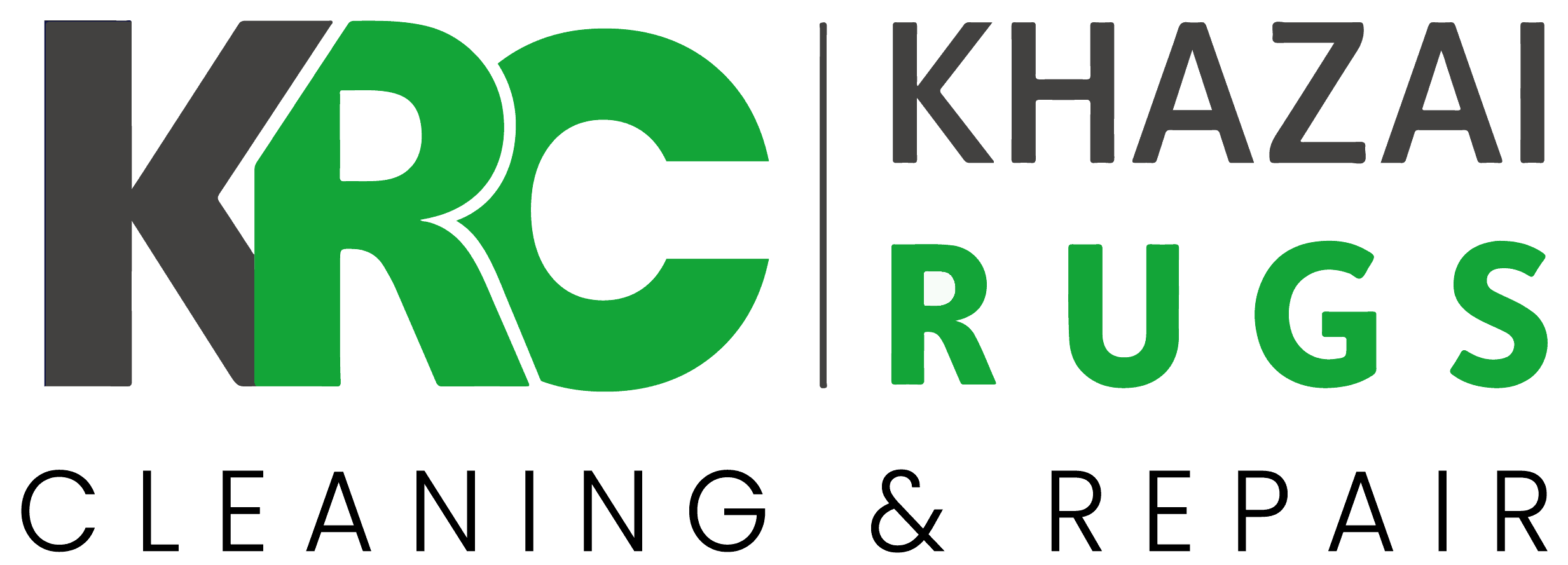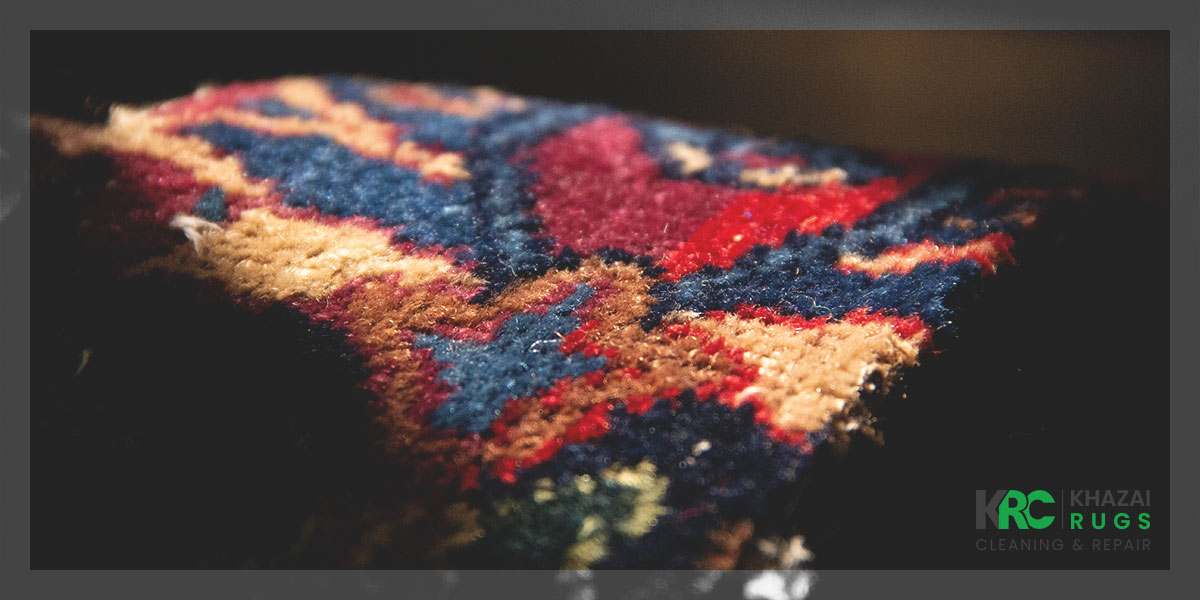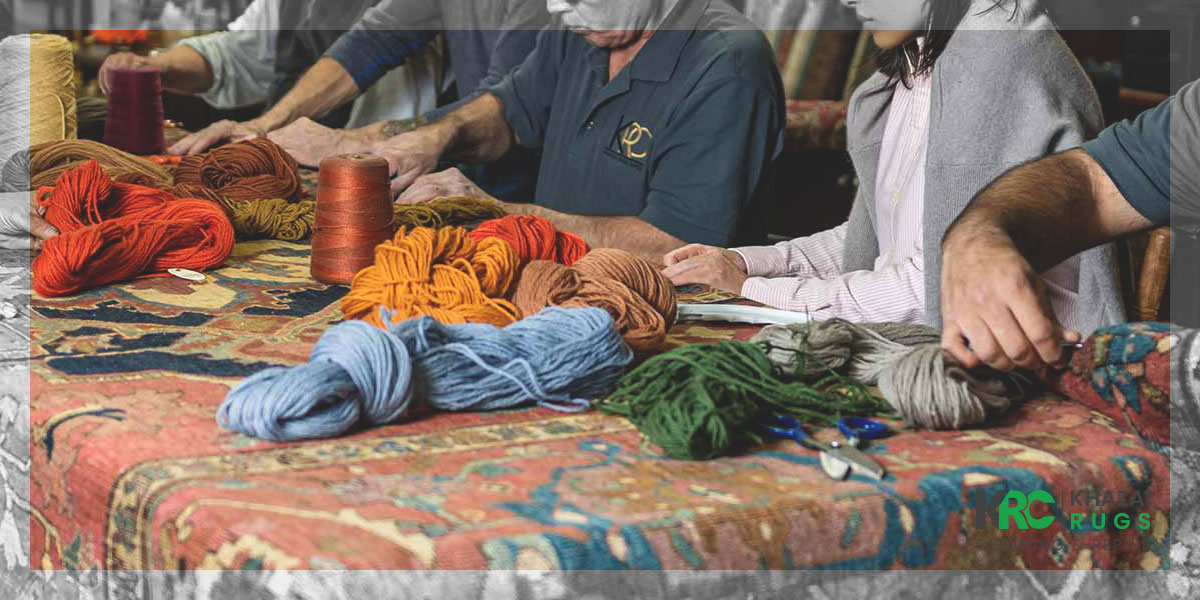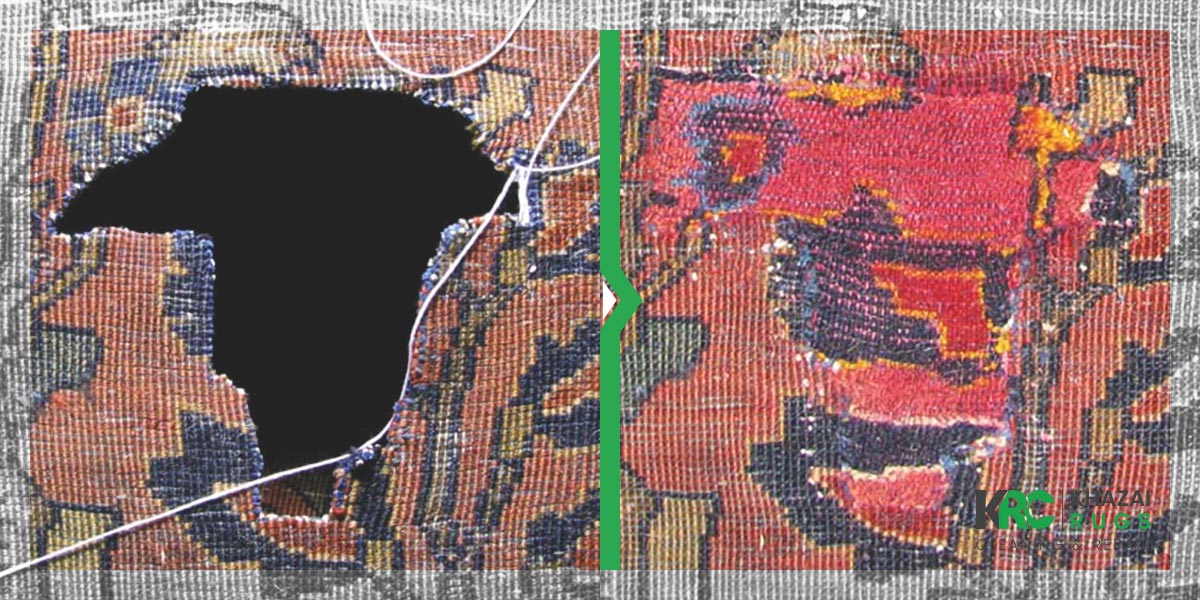Everything You Need To Know About Oriental Rug Repair!
Oriental rugs add elegance, color, and warmth to the floor and enhance the entire room’s look. If you put one in any room, you wish it could stay undamaged for too long. However, Oriental rugs are prone to various damages by nature. Several factors can damage their delicate fibers, such as wear and tear, pet damage, or discoloration.
This blog will walk you through the world of rug restorations and teach you how to repair Oriental rug. So first, let’s learn the common signs that indicate the need for repair.
Before Read : How Much Does It Cost To Repair Oriental Rugs?
What Are The Common Signs Of Oriental Rug Damage?
Oriental rugs are exquisite pieces of art that deserve careful attention and maintenance. To ensure their longevity, it’s crucial to be aware of common signs of damage. These signs include:
- Frayed Fringes: Fringes that appear tattered or unraveled are a clear indication of wear and tear. Fringes should be neatly trimmed and maintained to preserve the rug’s appearance.
- Color Fading: Sun exposure or chemical reactions can cause colors to fade. A once-vibrant rug can lose its luster over time, particularly in areas that receive more light.
- Stains and Spills: Unsightly stains or spills can be caused by accidents or spills. Immediate and proper cleaning is essential to prevent permanent damage.
- Tears and Holes: Physical damage, such as tears or holes in the rug, can occur from heavy foot traffic or accidents. These need immediate repair to prevent further harm.
- Wrinkles or Ripples: Uneven stretching or shifting of the rug’s fibers can lead to wrinkles or ripples on the surface. This can be a sign of improper installation or movement.
- Moth Damage: Tiny holes, often near the edges of the rug, can indicate moth infestations. These pests can cause significant harm to the rug’s fibers.
- Worn Pile: Over time, the rug’s pile, or surface texture, can become flattened or worn down in high-traffic areas, impacting its softness and appearance.
Being vigilant and addressing these common signs of Oriental rug damage promptly can help preserve the beauty and value of your cherished rug for years to come.
Does the Low Pile indicate that it’s time for Oriental Rug Repair?
The low pile is not a big problem compared to the damaged edges or sides. However, an extremely low pile could expose the foundation and cause severe damage to the rug. Some rug owners do not care about the low pile as it is a sign of age and character, and fixing it is just a matter of choice.
The need for Oriental Rug Repair depends on how well the rug is worn. If the pile is so low that the foundation is obvious, then you need an Oriental rug repair. The person in charge of Oriental rug repair should find exactly matching fabrics and dyes to use, so the rug would look untouched once the rug repair is over.
Why Is Professional Repair Essential?
Professional repair for Oriental rugs is indispensable due to the expertise and experience that specialists bring to the task. These professionals possess a deep understanding of rug materials, weaving techniques, and traditional methods, allowing them to accurately assess the extent of damage and tailor their approach to the unique needs of each rug. This ensures that the restoration work maintains or enhances the rug’s value and aesthetics.
Furthermore, professional repair preserves the rug’s structural integrity, including its foundation and fringes. They employ techniques that not only restore the rug’s beauty but also ensure it remains strong and durable. DIY repair attempts, well-intentioned though they may be, can inadvertently lead to further harm, potentially compromising the rug’s longevity and worth.
Aesthetic considerations are also paramount in professional restoration. Oriental rugs are renowned for their intricate and captivating designs. Specialists execute repairs with great attention to detail, ensuring that the rug’s visual appeal remains intact. Additionally, they have access to a wide array of materials that closely match the rug’s original components, ensuring a seamless and harmonious blend that DIY attempts may struggle to achieve. Ultimately, entrusting your Oriental rug to professional repair experts guarantees that it receives the care and attention it deserves, safeguarding both its monetary and sentimental value.
How Can I Repair My Oriental Rug at Home?
While minor repairs to Oriental rugs can be done at home, it’s important to note that significant or delicate repairs are best left to professionals. Here are some basic steps for small repairs:
- Gather Materials:
You’ll need a matching thread or yarn, a curved needle, scissors, and a piece of mesh or fabric that closely matches the rug’s foundation.
- Assess the Damage:
Identify the type of damage your rug has, such as a small tear, a loose fringe, or a pulled thread.
- Repairing a Small Tear:
For small tears, you can sew the edges together using a curved needle and matching thread. Be gentle and ensure the repair blends in with the rug’s pattern.
- Fixing Loose Fringes:
To repair loose or unraveled fringes, use a matching thread to secure them. If the fringes are significantly damaged, consider trimming them carefully.
- Repairing a Pulled Thread:
For pulled threads, carefully push the thread back into place using a blunt needle or hook. Secure it by sewing the surrounding fibers together.
- Use a Fabric Patch:
If your rug has a hole or significant damage, consider using a matching piece of fabric or mesh to patch it. Carefully sew the patch onto the rug’s foundation, ensuring the colors and pattern match.
- Test Your Repair:
Always test your repair in an inconspicuous area of the rug to make sure it looks good and holds securely.
Keep in mind that while minor repairs can be attempted at home, any extensive damage or intricate restoration work should be entrusted to professional rug repair specialists. They have the expertise and tools to ensure the rug is restored properly without causing further harm.
Also Read: The Top-Quality Rug Side Binding Repair.
How Do Professionals Restore Your Oriental Rugs?
Professionals employ a meticulous and specialized process for restoring Oriental rugs. First they begin by thoroughly assessing the rug’s condition, identifying the type and extent of damage, including fringes, tears, color fading, stains, and pile wear. They use specific techniques and cleaning agents designed for Oriental rugs to remove dirt, dust, and stains without causing harm to the fibers.
Color Restoration:
If the rug has color fading, experts use color restoration methods to restore the vibrancy of the original hues. This involves careful dyeing techniques.
Need Color restoration services? Click Here
Tears and Holes:
Tears, holes, and other physical damage are skillfully repaired. Professionals use matching materials and meticulous weaving methods to ensure the repair seamlessly blends in with the rug’s design.
Fringe Repair:
Fringes are cleaned, repaired, and secured to the rug’s foundation to maintain their appearance and structural integrity.
Moth and Pest Damage Treatment:
If the rug has suffered from moth or pest damage, professionals address the issue using appropriate treatments to prevent further infestations.
Blocking and Stretching:
To maintain the rug’s original shape and dimensions, experts may block and stretch it.
Final Cleaning and Inspection:
After all the repairs are completed, the rug undergoes a final cleaning to remove any residues. It is then thoroughly inspected to ensure all restoration work meets high standards.
Protecting and Storing:
Once the restoration is complete, professionals may offer recommendations for proper care, storage, and protection of the rug to maintain its condition over time.
If you want to know more about the process of repairing some of the damages by professionals, read the following sections to get more detailed information.
The Process of Oriental Rug Color Restoration
Oriental rugs are celebrated for their vibrant and intricate designs, making color restoration a crucial aspect of their preservation. Over time, exposure to sunlight, foot traffic, and environmental factors can lead to fading or discoloration. Color restoration aims to revitalize the rug’s original brilliance and enhance its overall aesthetic appeal. Here’s a detailed look at the process of Oriental rug color restoration:
Assessment
The process begins with a thorough assessment of the rug’s condition. Experts examine the extent and type of color damage, identifying areas where fading or discoloration is most prominent.
Gentle Cleaning
Before addressing color issues, the rug undergoes a gentle cleaning process to remove dirt, dust, and any contaminants that might affect the restoration process. Using specially formulated cleaning agents, professionals ensure the rug’s surface is free of debris.
Color Matching
A critical step in color restoration is identifying and matching the rug’s original colors. Experts have access to an extensive range of dyes and pigments, and they painstakingly blend colors to achieve an accurate match.
Testing
Prior to full-scale restoration, a test is conducted in an inconspicuous area to verify that the color blend is perfect and will produce the desired results.
Hand Dyeing
In many cases, color restoration is a meticulous, hand-dyeing process. Highly skilled professionals use small brushes and techniques such as color layering and shading to reintroduce the rug’s original colors. This process requires precision and an in-depth understanding of color theory.
Control of Saturation
The professionals maintain control over the saturation of colors, ensuring that the restored areas seamlessly blend with the adjacent parts of the rug. Achieving a balanced, harmonious appearance is essential.
Drying and Final Inspection
Once the color restoration is complete, the rug is carefully dried in a controlled environment to prevent any color migration. A final inspection is carried out to confirm that the colors have been restored to their original brilliance.
Color restoration is a delicate art that requires experience, expertise, and a deep understanding of the rug’s materials and dyes. When executed by professionals, this process can breathe new life into a faded or discolored Oriental rug, preserving its aesthetic charm for generations to come.
Water Damage Restoration for Oriental Rugs
Oriental rugs, with their intricate designs and rich materials, are highly susceptible to water damage. Whether caused by flooding, leaks, or spills, water damage can quickly compromise the structural integrity and aesthetics of these treasured pieces. Here’s an overview of the water damage restoration process for Oriental rugs:
Immediate Action:
Prompt action is crucial when water damage occurs. The first step is to remove the rug from the damp area to prevent further water absorption and potential mold growth.
Drying the Rug:
The rug is carefully laid out in a dry, well-ventilated area. Depending on the extent of the water damage, professionals may use specialized equipment like dehumidifiers and fans to expedite the drying process. It’s essential to ensure that the rug is thoroughly dry to prevent mold and mildew growth.
Inspection:
After drying, the rug is closely inspected for any signs of damage, such as color bleeding, shrinkage, or structural issues. These issues are addressed in subsequent steps.
Color and Structure Restoration:
If the rug has experienced color bleeding or structural problems, professionals will address these issues with specialized techniques. This may include color restoration and reweaving to bring the rug back to its pre-damaged condition.
Mold and Mildew Prevention:
Mold and mildew can be a significant concern after water damage. Professionals take measures to prevent their growth through thorough drying and treatment with anti-microbial agents.
Cleaning and Sanitization:
The rug is cleaned and sanitized to remove any contaminants that the water may have brought in. This step ensures the rug is safe to use and free from odors.
Final Inspection:
The rug undergoes a final inspection to verify that the restoration work has been successful and that it is safe for use. Any remaining issues are addressed at this stage.
Water damage restoration for Oriental rugs requires expertise and a deep understanding of the rug’s materials and construction. DIY attempts can often lead to further harm, including mold growth and structural damage. Trusting your valuable Oriental rug to professionals ensures a thorough and effective restoration process, preserving the rug’s beauty and longevity.
How Does Rug Resizing Work for Oriental Rugs?
When an Oriental rug becomes damaged or shows signs of wear, resizing or altering it can be an effective way to salvage its value and beauty. There are often two options for resizing your rugs:
- Cutting and Trimming: To resize a rug, experts may carefully trim the edges to reduce its dimensions while maintaining the original pattern and design.
- Rebinding: If the rug’s edges are frayed or damaged, rebinding can reinforce and reshape them, giving the rug a fresh, well-defined appearance.
Here is the process of rug resizing delicately performed by rug experts:
- Evaluation: The process begins with a thorough assessment of the rug’s condition. Specialists identify the areas that require resizing or alteration.
- Pattern Replication: In cases where trimming or resizing is necessary, professionals carefully replicate the rug’s existing pattern and design to ensure the alteration seamlessly blends with the rest of the rug.
- Border Creation: If the rug needs new borders after resizing, experts create these borders with a keen eye for design, ensuring they harmonize with the rug’s original aesthetic.
- Cutting and Resizing: Precise measurements are taken, and the rug is carefully cut and resized to the desired dimensions. Specialists employ meticulous techniques to maintain the rug’s structural integrity and visual appeal.
- Rebinding: If the edges require rebinding, this step reinforces and reshapes them to prevent further fraying and wear.
- Final Inspection: The resized or altered rug undergoes a final inspection to confirm that it not only meets the required dimensions but also aligns perfectly with the original pattern and design.
Resizing or altering an Oriental rug is a delicate process that demands expertise and an acute understanding of the rug’s materials and designs. When executed by professionals, this process can extend the life and value of a damaged rug, preserving its beauty for years to come.
How to Prevent Bug Damage to Oriental Rugs?
Oriental rugs are susceptible to damage from common pests like moths and carpet beetles. To safeguard your cherished rugs, consider these tips for preventing bug damage:
- Regular Cleaning
- Rotate Your Rug
- Use Rug Pads
- Inspect for Infestations
- Storage
- Natural Deterrents
- Professional Cleaning
- Avoid DIY Pest Treatments
Regular Cleaning:
Keep your rugs clean to remove food particles and organic matter that can attract pests. Vacuum both sides of the rug at least once a month.
Rotate Your Rug:
Occasionally rotate your rug to expose all areas to light and air. Pests thrive in dark, undisturbed areas.
Use Rug Pads:
Place rug pads underneath your rugs. They create a barrier that makes it difficult for pests to reach the rug.
Inspect for Infestations:
Periodically inspect your rugs for signs of infestations, such as small holes or larvae. If you notice any issues, take action promptly.
Storage:
When storing rugs, ensure they are cleaned, completely dry, and stored in a well-sealed bag or container to prevent pests from reaching them.
Natural Deterrents:
Use natural pest deterrents like cedar blocks or lavender sachets in the vicinity of your rugs. These natural scents are known to repel pests.
Professional Cleaning:
Schedule professional rug cleaning every few years. This not only cleans your rug but also helps prevent pest infestations by eliminating any eggs or larvae.
Avoid DIY Pest Treatments: Refrain from using DIY pest treatments directly on your rugs, as these chemicals may damage the fibers or dyes.
Follow these preventive measures, and you can significantly reduce the risk of bug damage to your Oriental rugs, preserving their beauty and value for years to come.
How to Choose a Trusted Oriental Rug Repair Service?
When selecting a trusted Oriental rug repair service, look for a company with a solid reputation and a history of expertise in handling Oriental rugs. Check for certifications, such as membership in the Association of Rug Care Specialists, which demonstrates a commitment to industry standards. Additionally, ask for referrals from friends or online reviews to gauge the experiences of previous customers.
Ensure that the service employs skilled artisans and professionals who are knowledgeable about different rug types and techniques, from color restoration to structural repairs. Transparency in the repair process, fair pricing, and clear communication are also essential criteria for choosing a reputable service that can breathe new life into your treasured Oriental rug.
Need rug repair service ? Click Here
What Factors Influence the Oriental Rug Repair Cost?
The cost of repairing Oriental rugs is influenced by a variety of factors, each playing a crucial role in determining the final price. Understanding these factors helps in obtaining accurate estimates and ensuring that your Oriental rug repair is completed professionally and cost-effectively. Here are the factors that can increase or decrease the restoration cost:
Type and Extent of Damage
- Rug Size
- Material and Dye Quality
- Pattern Complexity
- Professional Expertise
- Color Restoration
- Transportation and Handling
- Urgency
- Location
Oriental Rug Maintenance Tips for Prolonging Lifespan
Oriental rugs are not only beautiful but also valuable investments. To ensure they stand the test of time and retain their allure, consider these essential maintenance tips:
- Regular Vacuuming: Vacuum your rug on a weekly basis to remove dirt, dust, and debris. Use a brush attachment or a vacuum with adjustable settings for delicate rugs.
- Rotate Periodically: Rotate the rug every 6-12 months to ensure even wear and sun exposure. This helps prevent fading and damage to specific areas.
- Use Rug Pads: Place rug pads beneath your Oriental rug to prevent slipping, reduce friction, and provide cushioning. Rug pads also create a barrier against moisture and pests.
- Prompt Cleaning: Treat spills and stains immediately with a gentle blotting motion, using a clean, white cloth and mild detergent. Avoid rubbing, as it can push the stain deeper into the fibers.
- Professional Cleaning: Schedule professional rug cleaning every 1-3 years, depending on usage. This deep cleaning removes embedded dirt and revitalizes the rug’s colors.
- Protect from Sunlight: Limit direct sunlight exposure to prevent color fading. Consider using window treatments or UV-blocking films on windows.
- Avoid Heavy Furniture: Minimize the use of heavy furniture on your rug to prevent crushing or indentations. If furniture is placed on the rug, use furniture pads.
- Moth and Pest Prevention: Use natural deterrents like cedar blocks or lavender sachets to repel moths and pests. Regularly inspect the rug for signs of infestations.
- Storage Care: When storing your rug, ensure it’s clean, fully dry, and stored in a well-sealed, dry area, rolled rather than folded.
By following these maintenance tips, you can extend the life and preserve the beauty of your Oriental rug, allowing it to grace your home with its elegance for years to come.
Final Words
Your Oriental rug is more than just a floor covering; it’s a piece of art and a valuable asset. To ensure it continues to shine and stand the test of time, diligent maintenance is essential. By following these maintenance tips, you can significantly extend the life and preserve the innate beauty of your rug. From regular vacuuming to prompt stain treatment, professional cleaning, and protection from sunlight and pests, each tip plays a crucial role in safeguarding your cherished rug.
At Khazai Rug Cleaning, we understand the significance of Oriental rugs and offer a range of services to help you maintain their splendor. From professional cleaning to expert repair, we’re here to ensure your rug remains a centerpiece of elegance in your home. Trust Khazai Rug Cleaning to safeguard the artistry and value of your Oriental rug. Contact us today for all your rug cleaning and repair needs. Your rug deserves nothing less.






